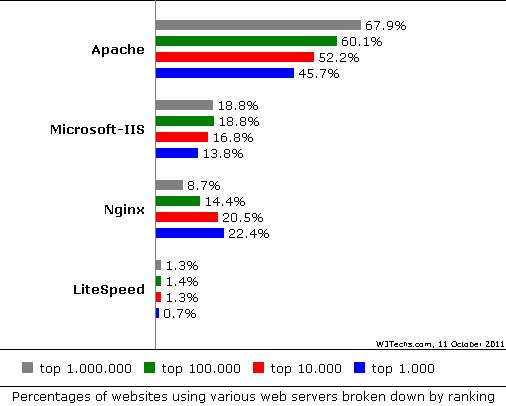Apache and IIS' Web server rival NGINX is growing fast


According to Netcraft, the leading Web server analytics company, NGINX, with its over 40-million Web domains and 8.5% of all Web domains, is catching up with the big two. Indeed Netcraft analysts believe that "If current trends continue NGINX will soon overtake Microsoft to have the second largest number of active sites."
NGINX has moved into this position because it's very, very fast. The company claims that NGINX can deliver 10 times the performance on the same hardware. I don't know about that, but I do know on my own servers that NGINX is very fast and uses far less resources than Apache or IIS. It does this by being event-based. That means it doesn't spawn new processes or threads for each Web page request. The end result is that even as the load increases, memory use remains predictable.
NGINX can also be used to improve performance because it can be used as a reverse proxy. In this mode, NGINX looks like just another Web server to users. Behind the scenes, though the reverse proxy is used to load balance Web requests among several back-end servers, or to provide caching for a slower back-end server.
The net result is that NGINX provides very fast and stable Web services with minimal hardware. You don't have to take my word for it. Of the top 1,000 Web servers in the world, 22.4% use NGINX. These include such Web heavyweights as Facebook, Hulu, and WordPress.
Now, NGINX also has some cash to help it get even more clients. The company has just received $3 million in a fully subscribed Series A round from BV Capital and Runa Capital, and an entity affiliated with MSD Capital, Dell CEO Michael Dell's private investment firm. The funding will be used to support the company's plans for its new commercial arm, Nginx Inc., and its expansion into the U.S.
They're investing in it, because, as Thomas Gieselmann co-founder of BV Capital, said in a statement, "Several of the companies we invested in were able to solve significant scaling issues by switching their web platforms to NGINX. NGINX transparently and effectively enables the growth of the largest sites on the Internet today."
With this funding the NGINX teams plans on opening its new San Francisco headquarters by year's end and by the middle of 2012, the company will be offering what it calls "a commercial-grade connection processing and optimization software platform, which will enable advanced performance, traffic management, extended configuration and security features for hosting, cloud and enterprise server infrastructure. NGINX will also offer flexible options to upgrade existing web installations to modern and efficient high density web software." In short, NGINX is taking their open-source project and aimming straight for the top of the corporate Web server market.
At the rate NGINS is growing, and IIS is declining, I expect that by the end of 2012, NGINX may well be the number two Web server in the world. If you're involved at all in Web services, it's time to look into NGINX. It's going to be part of your future.
Web server statistics image courtesy of W3Techs.
Related Stories:
Oracle's big data appliance: Ready, set, wait?
Apache is being forced into a Java Fork